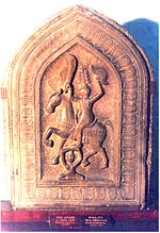
Kalki
Overview
Hinduism
Hinduism is the predominant and indigenous religious tradition of the Indian Subcontinent. Hinduism is known to its followers as , amongst many other expressions...
, Kalki (Devanagari
Devanagari
Devanagari |deva]]" and "nāgarī" ), also called Nagari , is an abugida alphabet of India and Nepal...
: कल्कि; also rendered by some as KalKin and Kalaki) is the tenth and final Maha Avatar
Avatar
In Hinduism, an avatar is a deliberate descent of a deity to earth, or a descent of the Supreme Being and is mostly translated into English as "incarnation," but more accurately as "appearance" or "manifestation"....
(great incarnation) of Vishnu
Vishnu
Vishnu is the Supreme god in the Vaishnavite tradition of Hinduism. Smarta followers of Adi Shankara, among others, venerate Vishnu as one of the five primary forms of God....
who will come to end
Messiah
A messiah is a redeemer figure expected or foretold in one form or another by a religion. Slightly more widely, a messiah is any redeemer figure. Messianic beliefs or theories generally relate to eschatological improvement of the state of humanity or the world, in other words the World to...
the present age of darkness and destruction known as Kali Yuga
Kali Yuga
Kali Yuga is the last of the four stages that the world goes through as part of the cycle of yugas described in the Indian scriptures. The other ages are Satya Yuga, Treta Yuga and Dvapara Yuga...
. The name Kalki is often a metaphor for eternity
Eternity
While in the popular mind, eternity often simply means existence for a limitless amount of time, many have used it to refer to a timeless existence altogether outside time. By contrast, infinite temporal existence is then called sempiternity. Something eternal exists outside time; by contrast,...
or time
Time
Time is a part of the measuring system used to sequence events, to compare the durations of events and the intervals between them, and to quantify rates of change such as the motions of objects....
. The origins of the name probably lie in the Sanskrit
Sanskrit
Sanskrit , is a historical Indo-Aryan language and the primary liturgical language of Hinduism, Jainism and Buddhism.Buddhism: besides Pali, see Buddhist Hybrid Sanskrit Today, it is listed as one of the 22 scheduled languages of India and is an official language of the state of Uttarakhand...
word "kalka" which refers to mud, dirt, filth, or foulness and hence denotes the "destroyer of foulness," "destroyer of confusion," "destroyer of darkness," or "annihilator of ignorance." Other similar and divergent interpretations based on varying etymological derivations from Sanskrit - including one simply meaning "White Horse
White horse (mythology)
White horses have a special significance in the mythologies of cultures around the world. They are often associated with the sun chariot, with warrior-heroes, with fertility , or with an end-of-time saviour, but other interpretations exist as well...
" - have been made.
In the Buddhist
Buddhism
Buddhism is a religion and philosophy encompassing a variety of traditions, beliefs and practices, largely based on teachings attributed to Siddhartha Gautama, commonly known as the Buddha . The Buddha lived and taught in the northeastern Indian subcontinent some time between the 6th and 4th...
Kalachakra
Kalachakra
Kalachakra is a Sanskrit term used in Tantric Buddhism that literally means "time-wheel" or "time-cycles".The spelling Kalacakra is also correct....
tradition, some 25 rulers of the legendary Shambhala
Shambhala
In Tibetan Buddhist tradition, Shambhala or Shangri-la is a mythical kingdom hidden somewhere in Inner Asia...
Kingdom have the title of Kalki, Kulika or Kalki-king.
Hindu traditions permit numerous interpretations of what avatars are and to what purpose they act.

